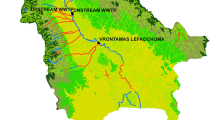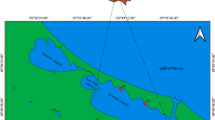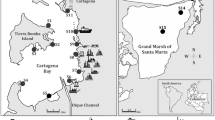Abstract
Urban tropical lagoons are often impacted by eutrophication, metal, and polycyclic aromatic hydrocarbon (PAH) contamination, but the toxicity of their bottom sediments is still poorly investigated in South America. Aiming to contribute to filling this gap, a sediment quality assessment was conducted in the Tijuca Lagoon (Rio de Janeiro, Brazil) using different lines of evidence (LOEs) including sediment characterization, determination of metals and PAHs, and acute toxicity testing with burrowing amphipods (Tiburonella viscana). Mud and organic matter contents played a crucial role in contaminant distribution along the lagoon. The concentrations of PAH were generally low (mean ΣPAH = 795.42 ± 1146.2 ng/g; n = 23), but a contamination hotspot of light PAH compounds was identified. Such PAHs were mainly pyrolytic, probably related to the deposition of atmospheric pollution, although petrogenic compounds also occur in the lagoon. The data indicated the occurrence of geochemical anomalies of Zn, Cu, Pb, and Hg (mean values = 176.9 ± 91.6, 45.1 ± 21.3, 35.2 ± 15.0, 0.1442 ± 0.0893 mg/kg, respectively; n = 23), probably associated with industrial wastes, garbage deposition, urban runoff, and domestic sewage contributions. The mortality of T. viscana was significant for more than 85% of the samples (mean mortality = 70.3 ± 26.0%; n = 23), but it was not significantly correlated with PAH and metal concentrations. On the other side, domestic sewage contributions and eutrophication seem to play a relevant role in sediment toxicity. Actually, the toxicity observed in the tests seems to be due to the simultaneous influence of multiple toxicants and their combined effects on the organisms. Such stressors may include not only metals, PAH, and eutrophication but also chemicals not evaluated in this study, such as hormones, pharmaceuticals and personal care compounds, perfluorocompounds, detergents, and others.







Similar content being viewed by others
Data availability
Not applicable.
References
Associação Brasileira de Normas Técnicas (ABNT) (2016) NBR 15638:2016. Ecotoxicologia aquática - Toxicidade aguda - Método de ensaio com anfípodos marinhos e estuarinos em sedimentos. ABNT, São Paulo
Ab’Saber AN (1977) Os domínios morfoclimáticos na América do Sul. Geomorfologia 52(1):1–22
Araújo GS, Cruz CCF, Gusso-Choueri PK, Saint’Pierre TD, Hauser-Davis RA, Martins CC, Abessa DMS (2020) Sediment quality of a Ramsar site assessed by chemical and ecotoxicological approaches. Reg Stud Mar Sci 35:101145. https://doi.org/10.1016/j.rsma.2020.101145
Ali I, Aboul-Enein HY (2002) Speciation of metal ions by capillary electrophoresis. Crit Rev Anal Chem 32(4):337–350. https://doi.org/10.1080/10408340290765597
Ali I, Gupta VK, Aboul-Enein HY (2005) Metal ion speciation and capillary electrophoresis: application in the new millennium. Electrophoresis 26(21):3988–4002. https://doi.org/10.1002/elps.200500216
Ali I, Hasan MA, Alharbi OM (2020) Toxic metal ions contamination in the groundwater, Kingdom of Saudi Arabia. J Taibah Univ Sci 14(1):1571–1579. https://doi.org/10.1080/16583655.2020.1847807
Araruna-Junior JT, Benedetti PE, Pires PJM, Almeida RFR (2012) Sediments quality assessment of Jacarepaguá Lagoon: the venue of the 2011 rock in Rio. CLEAN–Soil Air Water 40(9):906–910. https://doi.org/10.1002/clen.201100667
Balcioğlu EB, Gönülal O, Güreşen SO, Aksu A, Öztürk B (2018) Comparison and origins of polycyclic aromatic hydrocarbons (PAHs) in the entrance and the exit of the Turkish Straits System (TSS). Mar Pollut Bull 136:33–37. https://doi.org/10.1016/j.marpolbul.2018.08
Barcellos CC, Fernandes HM, Azevedo HL (1988) The role of the Arroio Pavuna river in the transport of particulate heavy metals to Jacarepaguá Lagoon, Brazil. Sci Total Environ 75(1–2):211–223. https://doi.org/10.1016/0048-9697(88)90034-4
Bastami KD, Neyestani MR, Shemirani F, Soltani F, Haghparast S, Akbari A (2015) Heavy metal pollution assessment in relation to sediment properties in the coastal sediments of the southern Caspian Sea. Mar Pollut Bull 92(102):237–243. https://doi.org/10.1016/j.marpolbul.2014.12.035
Bidone E, Cesar R, Santos MC, Sierpe R, Silva-Filho EV, Kutter V, Silva LI, Castilhos Z (2018) Mass balance of arsenic fluxes in rivers impacted by gold mining activities in Paracatu (Minas Gerais State, Brazil). Environ Sci Pollut Res Int 25:9085–9100. https://doi.org/10.1007/s11356-018-1215-z
Cabral S (1979) Mapeamento Geológico-Geotécnico da Baixada de Jacarepaguá e maciços circunvizinhos. Dissertation, Federal University of Rio de Janeiro
Campos BG, Moreira LC, Pauly GFE, Cruz ACF, Monte CN, Silva LID, Rodrigues APC, Machado W, Abessa DMS (2019) Integrating multiple lines of evidence of sediment quality in a tropical bay (Guanabara Bay, Brazil). Mar Pollut Bull 146:925–934. https://doi.org/10.1016/j.marpolbul.2019.07.051
Castilhos Z, Rodrigues-Filho S, Cesar R, Rodrigues AP, Villas-Bôas R, De Jesus I, Lima M, Faial K, Miranda A, Brabo E, Beinhoff C, Santos E (2015) Human exposure and risk assessment associated with mercury contamination in artisanal gold mining areas in the Brazilian Amazon. Environ Sci Pollut Res Int 22:11255–11264. https://doi.org/10.1007/s11356-015-4340-y
Cesar R, Colonese J, Silva M, Egler SG, Bidone E, Castilhos Z, Polivanov H (2011) Distribuição de mercúrio, cobre, chumbo, zinco e níquel em sedimentos de corrente da bacia do rio Piabanha, Estado do Rio de Janeiro. Geochimica Brasiliensis 25:35–45. https://doi.org/10.21715/gb.v25i1.330
Cesar RG, Arruda F, Ramiro V, Faria R, Barcelos D, Pontes F, Passos F, Kaiser K, Teixeira AMS, Serrano A, Abreu L, Siqueira D, Teixeira M, Vezzone M, Polivanov H, Castilhos Z (2021) Deposition of gold mining tailings in tropical soils: metal pollution and toxicity to earthworms. Journal of Soils and Sediments, in presshttps://doi.org/10.1007/s11368-021-03105-8
Cruz ACF, Pauly GFE, Araújo GS, Gusso-Choueri P, Fonseca TG, Campos BG, Santelli RE, Freire AS, Braz BF, Bosco-Santos A, Luiz-Silva W, Machado W, Abessa DMS (2021) Metal Bioaccumulation by the Neotropical Clam Anomalocardia flexuosa to Estimate the Quality of Estuarine Sediments. Bull Environ Contam Toxicol 107:106–113. https://doi.org/10.1007/s00128-020-03062-x
Conselho Nacional do Meio Ambiente (CONAMA) (2012) Resolução 454. http://www.ibama.gov.br/component/legislacao/?view=legislacao&legislacao=128537. Accessed 12 Nov 2021
Cypriano EF (2009) Distribuição espacial de mercúrio nos sedimentos do Complexo Lagunar da Baixada de Jacarepaguá (RJ). Dissertation, State University of Rio de Janeiro
Deckere E, Cooamn W, Leloup V, Meire P, Schmitt C, Von der Ohe PC (2011) Development of sediment quality guidelines for freshwater ecosystems. J Soils Sediments 11:504–517. https://doi.org/10.1007/s11368-010-0328-x
EMBRAPA (Empresa Brasileira de Pesquisa Agropecuária - Brasil) (1997) Centro Nacional de Pesquisa de Solos. In: Manual de Métodos de Análises de Solo. Rio de Janeiro: Embrapa Solos
Fang X, Li X, Zhang Y, Zhao Y, Qian J, Hao C, Zhou J, Wu Y (2021) Random forest-based understanding and predicting of the impacts of anthropogenic nutrient inputs on the water quality of a tropical lagoon. Environ Res Lett 16(5):055003. https://doi.org/10.1088/1748-9326/abf395
Farias HS (2015) Indicadores Sintéticos de Qualidade de Vida Aplicados na Região Metropolitana do Rio de Janeiro. Continentes 6:6–26
Fernandes HM, Cardoso K, Godoy JMO, Patchineelam SR (1993) Cultural impact on the geochemistry of sediments in Jacarepaguá lagoon, Rio de Janeiro, Brazil. Environ Technol 14(1):93–100. https://doi.org/10.1080/09593339309385267
Gallen C, Eaglesham G, Drage D, Nguyen TH, Mueller JF (2018) A mass estimate of perfluoroalkyl substance (PFAS) release from Australian wastewater treatment plants. Chemosphere 208:975–983. https://doi.org/10.1016/j.chemosphere.2018.06.024
Gao L, Wang Z, Li S, Chen J (2018) Bioavailability and toxicity of trace metals (Cd, Cr, Cu, Ni, and Zn) in sediment cores from the Shima River, South China. Chemosphere 192:31–42. https://doi.org/10.1016/j.chemosphere.2017.10.110
Gupta VK, Ali I, Khurana U, Dhagarra N (1995) TLC separation of transition metal ions and their quantitative estimation by atomic absorption spectroscopy. J Liq Chromatogr Relat Technol 18(8):1671–1681. https://doi.org/10.1080/10826079508009304
Håkanson L (1980) An ecological risk index for aquatic pollution control. A sedimentological 253 approach. Water Res 14(8):975–1001. https://doi.org/10.1016/0043-1354(80)90143-8
Hauser-Davis RA, Lavradas RT, Lavandier RC, Rojas EGA, Guarino AWS, Ziolli RL (2015) Accumulation and toxic effects of microcystin in tilapia (Oreochromis niloticus) from an eutrophic Brazilian lagoon. Ecotoxicol Environ Saf 122:132–136. https://doi.org/10.1016/j.ecoenv.2014.10.036
Hariri MSB, Abu-Zied RH (2018) Factors influencing heavy metal concentrations in the bottom sediments of the Al-Kharrar Lagoon and Salman Bay, eastern Red Sea coast, Saudi Arabia. Arab J Geoscie 11(17):1–20. https://doi.org/10.1007/s12517-018-3838-2
Inam E, Etuk I, Offiong N, Kim K, Kang S, Essien J (2018) Distribution and ecological risks of polycyclic aromatic hydrocarbons (PAHs) in sediments of different tropical water ecosystems in Niger Delta, Nigeria. Environ Earth Sci 77:216. https://doi.org/10.1007/s12665-018-7396-4
Kadokami K, Miyawaki T, Iwabuchi K, Takagi S, Adachi F, Iida H, Watanabe K, Kosugi Y, Suzuki T, Nagahora S, Tahara R, Orihara T, Eguchi A (2021) Inflow and outflow loads of 484 daily-use chemicals in wastewater treatment plants across Japan. Environ Monit Contam Res 1:1–16. https://doi.org/10.5985/emcr.20200002
Kothari M (1994) Tijuca lagoon; evictions and human rights in Rio de Janeiro. Environ Urban 6(1):63–73. https://doi.org/10.1177/095624789400600107
Kim J, Seo S, Kim Y, Kim DH (2018) Review of carcinogenicity of hexavalent chrome and proposal of revising approval standards for an occupational cancers in Korea. Ann Occup Environ Med 30(1) https://doi.org/10.1186/s40557-018-0215-2
Kwon HO, Kim HY, Park YM, Seok KS, Oh JE, Choi SD (2017) Updated national emission of perfluoroalkyl substances (PFASs) from wastewater treatment plants in South Korea. Environ Pollut 220:298–306. https://doi.org/10.1016/j.envpol.2016.09.063
Liess M, Foit K, Knillmann S, Schaefer RB, Liess H (2016) Predicting the synergy of multiple stress effects. Sci Rep 6:32965. https://doi.org/10.1038/srep32965
Loureiro D, Fernandez M, Herms F, Araújo C, Lacerda LD (2012) Distribuição dos metais pesados em sedimentos da Lagoa Rodrigo de Freitas. Oecologia Australis 16(3):353–364. https://doi.org/10.4257/oeco.2012.1603.04
Lumbreras JF, Gomes JBV (2004) Mapeamento Pedológico e Interpretações Úteis ao Planejamento Ambiental do Município do Rio de Janeiro. Embrapa Solos, Rio de Janeiro
Luz CP, Leite RS (2017) The Rio 16 Olympic Games: no gold medal for human rights respect. Revista Pensamento Jurídico 11(2):303–324
Magalhães L, Noyma NP, Furtado LL, Mucci M, Van Oosterhout F, Huszar VLM, Marinho MM, Lürling M (2017) Efficacy of coagulants and ballast compounds in removal of cyanobacteria (microcystis) from water of the tropical lagoon Jacarepaguá (Rio de Janeiro, Brazil). Estuaries Coasts 40:121–133. https://doi.org/10.1007/s12237-016-0125-x
Moal ML, Gascuel-Odoux C, Menesguen A, Souchon Y, Etrillard C, Levain A, Moatar F, Pannard A, Souchu P, Lefebvre A, Pinay G (2019) Eutrophication: a new wine in an old bottle? Sci Total Environ 651:1–11. https://doi.org/10.1016/j.scitotenv.2018.09.139
Monte C, Cesar R, Rodrigues AP, Siqueira D, Serrano A, Abreu L, Teixeira M, Vezzone M, Polivanov H, Castilhos Z, Campos T, Machado GGM, Souza WF, Machado W (2018) Spatial variability and seasonal toxicity of dredged sediments from Guanabara Bay (Rio de Janeiro, Brazil): acute effects on earthworms. Environ Sci Poll Res 25:34496–34509. https://doi.org/10.1007/s11356-018-3338-7
Monte CN, Rodrigues APC, Freitas AF, Braz BF, Freire AS, Cordeiro RC, Santelli RE, Machado WTV (2021) Ecological risks associated to trace metals of contaminated sediments from a densely urbanized tropical eutrophic estuary. Environ Monit Assess 193:767. https://doi.org/10.1007/s10661-021-09552-7
Moreira LB, Saes RVST, Pares TF, Taniguchi S, Bicego MC, Martins RV, Abessa DMSA (2019) Toxicity of sediments and dredged material from a semi-arid coastal system to marine invertebrates. Ecotoxicol Environ Contam 14(1):79–89. https://doi.org/10.5132/eec.2019.01.10
Moreira LB, Fernandes GM, Figueira RCL, Nascimento RF, Cavalcante RM, Machado WTV, Abessa DM (2021) Sediment contamination and toxicity of Marine Protected Areas in southeastern Brazilian coast: A baseline for management planning. Mar Pollut Bull 170:112613. https://doi.org/10.1016/j.marpolbul.2021.112613
Müller G (1979) Schwermetalle in den Sedimenten des Rheins-Veränderungen seit. Umschau 24:778–783
Newton A, Brito A, Icely J, Derolez V, Clara I, Angus S, Schernewski G, Inacio M, Lilebo A, Sousa A, Bejaoui B, Solidoro C, Tosic M, Canedo-Arguelles M, Yamamuro M, Reizopoulou S, Tseng HC, Canu D, Khokhlov V (2018) Assessing, quantifying and valuing the ecosystem services of coastal lagoons. J Nat Conserv 44:50–65. https://doi.org/10.1016/j.jnc.2018.02.009
Nguyen TN, Park M, Son J, Choi S (2021) Spatial distribution and temporal variation of polycyclic aromatic hydrocarbons in runoff and surface water. Sci Total Environ 793:148339. https://doi.org/10.1016/j.scitotenv.2021.148339
Nobre RL, Carneiro LS, Panek SE, González MJ, Vanni MJ (2019) Fish, including their carcasses, are net nutrient sources to the water column of a eutrophic lake. Front Ecol Evol 7:340. https://doi.org/10.3389/fevo.2019.00340
Pang SY, Suratman S, Latif MT, Khan MF, Simoneit BRT, Tahir NM (2021) Polycyclic aromatic hydrocarbons in coastal sediments of Southern Terengganu, South China Sea, Malaysia: source assessment using diagnostic ratios and multivariate statistic. Environ Sci Pollut Res. https://doi.org/10.1007/s11356-021-16762-6
Pellerin A, Antler G, Røy H, Findlay A, Beulig F, Scholze C, Turchyn A, Jørgensen BB (2018) The sulfur cycle below the sulfate-methane transition of marine sediments. Geochim Cosmochim Acta 239(15):74–89. https://doi.org/10.1016/j.gca.2018.07.027
Pérez A, Machado W, Sanders CJ (2021) Anthropogenic and environmental influences on nutrient accumulation in mangrove sediments. Mar Pollut Bull 165:112174. https://doi.org/10.1016/j.marpolbul.2021.112174
Rizzati V, Briand O, Guillou H, Gamet-Payrastre L (2016) Effects of pesticide mixtures in human and animal models: An update of the recent literature. Chem Biol Interact 25:231–246. https://doi.org/10.1016/j.cbi.2016.06.003
Rodrigues IYDC, Campos JDC, Cavalcante RM, Coutinho AC, Netto AT, Salomão AL (2020) Ecological risk assessment in sediments from the urbanized lagoon of the Olympic Park. Iranian (Iranica) J Energy Environ 11(4):287–291. https://doi.org/10.5829/ijee.2020.11.04.06
Sabino JA, Salomão ALS, Cunha PM, Coutinho R, Marques M (2021) Occurrence of organic micropollutants in an urbanized sub-basin and ecological risk assessment. Ecotoxicol. https://doi.org/10.1007/s10646-020-02304-2
Salloto GRB, Cardoso AM, Coutinho FH, Pinto LH, Vieira RP, Chaia C, Lima JL, Albano RM, Martins OB, Clementino MM (2012) Pollution impacts on bacterioplankton diversity in a tropical urban coastal lagoon system. PLoS One 7(11):e51175. https://doi.org/10.1371/journal.pone.0051175
Santos LO, Santos AG, Andrade JB (2018) Methodology to examine polycyclic aromatic hydrocarbons (PAHs) nitrated PAHs and oxygenated PAHs in sediments of the Paraguaçu River (Bahia, Brazil). Mar Pollut Bull 136:248–256. https://doi.org/10.1016/j.marpolbul.2018.09.022
Savage KM, Cesero P, Potter PE (1988) Mineralogic maturity of modern sand along a high-energy tropical coast: Baixada de Jacarepaguá, Rio de Janeiro, Brazil. J S Am Earth Sci 4(1):317–328. https://doi.org/10.1016/0895-9811(88)90020-X
Schlee MB, Jara SM, Martinez MI, Coelho Netto AL (2018) Effects of urban occupation in rivers morphology: the case study of Upper Pedras River, in Jacarepaguá District, at the Tijuca Massif. In: Leal Filho W, Esteves de Freitas L (eds) Climate Change Adaptation in Latin America. Springer, Cham. https://doi.org/10.1007/978-3-319-56946-8_9
Silva KM, Guimarães TCS, Wasserman JCF (2019) Distribuição espacial da concentração de nutrientes em sedimentos na Laguna hipersalina de Araruama–RJ, Brasil. Geochimica Brasiliensis 33(1):16–27. https://doi.org/10.21715/GB2358-2812.2019331016
Szefer P, Szefer K, Glasby GP, Pempkowiak J, Kaliszan R (1996) Heavy-metal pollution in surficial sediments from the Southern Baltic Sea off Poland. J Environ Sci Health, Part A 31:2723–2754. https://doi.org/10.1080/10934529609376520
Teodorović T (2009) Ecotoxicological research and related legislation in Serbia. Environ Sci Pollut Res 16:123–129. https://doi.org/10.1007/s11356-009-0152-2
Turekian KK, Wedepohl HK (1961) Distribution of the elements in some major units of the Earth’s crust. Geol Soc Am Bull 72:175–192
Vezzone M, Cesar R, Abessa DM, Serrano A, Lourenço R, Castilhos Z, Rodrigues AP, Perina FC, Polivanov H (2019) Metal pollution in surface sediments from Rodrigo de Freitas Lagoon (Rio de Janeiro, Brazil): Toxic effects on marine organisms. Environ Pollut 252:270–280. https://doi.org/10.1016/j.envpol.2019.05.094
Vezzone M, Anjos RM, Cesar RG, Muniz M, Cardoso R, Felizardo JP, Vasconcelos D, Polivanov H (2020) Using stable isotopes to discriminate anthropogenic impacts of the sedimentary organic matter pollution in the Rodrigo de Freitas Lagoon (RJ, Brazil). Environ Sci Pollut Res 28:4515–4530. https://doi.org/10.1007/s11356-020-10835-8
Webster L, Russel M, Shperd N, Packer G, Dalgarno EJ, Neat F (2018) Monitoring of polycyclic aromatic hydrocarbons (PAHs) in Scottish deepwater environments. Mar Pollut Bull 128:456–459. https://doi.org/10.1016/j.marpolbul.2018.01.049
Zhang M, Sun X, Xu J (2020) Heavy metal pollution in the East China Sea: a review. Mar Pollut Bull 159:111473. https://doi.org/10.1016/j.marpolbul.2020.111473
Acknowledgements
We are grateful to the geographer Danielle Soares and the boatman “Katatau” for their support during the sampling campaign.
Funding
The CNPq (National Brazilian Council for Scientific and Technological Development) and CAPES (Coordination for the Improvement of Higher Level -or Education- Personnel) Institutions provided grants to Matheus Teixeira (Master-CAPES), Rodrigo Lourenço (IC-CNPq), Yan Ribeiro (IC-CNPq), and Gustavo Koifman (IC-CNPq). The first author Matheus Teixeira was supported by a grant from CAPES (Brazilian Education Ministry—Grant number: 88887.481217/2020–00). Denis Abessa (grant #308533/2018–6) and Fernando Cesar Perina (grant CAPES #88887.124100/2016–00) were funded by CNPq and CAPES, respectively. FCT/MCTES provided financial support to CESAM (UIDP/50017/2020 + UIDB/50017/2020 + LA/P/0094/2020).
Author information
Authors and Affiliations
Contributions
All authors contributed to the study conception and design. The sampling of sediments (field work), material preparation,n and data collection were performed by Matheus Teixeira, Rodrigo Lourenço, Yan Ribeiro, and Gustavo Koifman. Metal determination and its interpretation were performed by Zuleica Castilhos, Matheus Teixeira, Ricardo Cesar, and Denis Abessa. Hydrocarbon determination and its interpretation were performed by Celeste Siqueira, Matheus Teixeira, and Ricardo Cesar. The ecotoxicological test was performed by Denis Abessa, Fernando Cesar Perina, and Matheus Teixeira. Physical and chemical properties of the sediments were determined and interpreted by Matheus Teixeira, Rodrigo Lourenço, Mariana Vezzone, Roberto Meigikos dos Anjos, and Helena Polivanov. Finally, the statistical treatment was performed by Mariana Vezzone, Denis Abessa, and Matheus Teixeira. The first draft of the manuscript was written by Matheus Teixeira and Ricardo Cesar, and all authors commented on previous versions of the manuscript. All authors read and approved the final manuscript.
Corresponding author
Ethics declarations
Ethical approval
This research involved the use of marine amphipods as test-organisms in laboratorial ecotoxicological tests. We guarantee the welfare of the animals used in this study.
Consent to participate
Not applicable.
Consent to publish
Not applicable.
Conflict of interest
The authors declare no competing interests.
Additional information
Responsible Editor: Christian Gagnon
Publisher's note
Springer Nature remains neutral with regard to jurisdictional claims in published maps and institutional affiliations.
Rights and permissions
Springer Nature or its licensor holds exclusive rights to this article under a publishing agreement with the author(s) or other rightsholder(s); author self-archiving of the accepted manuscript version of this article is solely governed by the terms of such publishing agreement and applicable law.
About this article
Cite this article
Teixeira, M., Cesar, R., Abessa, D. et al. Ecological risk assessment of metal and hydrocarbon pollution in sediments from an urban tropical estuary: Tijuca lagoon (Rio de Janeiro, Brazil). Environ Sci Pollut Res 30, 184–200 (2023). https://doi.org/10.1007/s11356-022-22214-6
Received:
Accepted:
Published:
Issue Date:
DOI: https://doi.org/10.1007/s11356-022-22214-6




